Electrical grid
An electrical grid, electric grid or power grid, is an interconnected network for delivering electricity from producers to consumers. It consists of:[1]
- generating stations that produce electric power
- electrical substations for stepping electrical voltage up for transmission, or down for distribution
- high voltage transmission lines that carry power from distant sources to demand-centers
- distribution lines that connect individual customers
| Part of a series on |
| Power engineering |
|---|
| Electric power conversion |
| Electric power infrastructure |
| Electric power systems components |

Electrical grids vary in size from covering a single building through national grids (which cover whole countries) to transnational grids (which can cross continents).
Power stations connected to grids are often located near energy resources such as a source of fuel or to take advantage of renewable energy resources, and away from heavily-populated areas. A bulk-power transmission network is therefore used to move the power long distances, sometimes across international boundaries, until it reaches its wholesale customer (usually the organisation that owns the local electric power distribution network). The electric power is therefore stepped up to a high voltage for the electric power transmission system. On arrival at a substation, the power will be stepped down from a transmission level voltage to a distribution-level voltage. As it exits the substation, it enters the distribution wiring. Finally, upon arrival at the service location, the power is stepped down again from the distribution voltage to the required service voltage(s).
Although electrical grids are widespread, as of 2016 1.4 billion people worldwide were not connected to an electricity grid.[2]
Electrical grids can be prone to malicious intrusion or attack; thus, there is a need for electric grid security. Also as electric grids modernize and introduce computers, cyber threats also start to become a security risk.[3] Particular concerns relate to the more complex computer systems needed to manage grids.[4]
History
Early electric energy was produced near the device or service requiring that energy. In the 1880s, electricity competed with steam, hydraulics, and especially coal gas. Coal gas was first produced on customer's premises but later evolved into gasification plants that enjoyed economies of scale. In the industrialized world, cities had networks of piped gas, used for lighting. But gas lamps produced poor light, wasted heat, made rooms hot and smoky, and gave off hydrogen and carbon monoxide. They also posed a fire hazard. In the 1880s electric lighting soon became advantageous compared to gas lighting.
Electric utility companies took advantage of economies of scale and moved to centralized power generation, distribution, and system management.[5] After the war of the currents was settled in favor of AC power, with long distance power transmission it became possible to interconnect stations to balance load and improve load factors.
In the United Kingdom, Charles Merz, of the Merz & McLellan consulting partnership, built the Neptune Bank Power Station near Newcastle upon Tyne in 1901,[6] and by 1912 had developed into the largest integrated power system in Europe.[7] Merz was appointed head of a Parliamentary Committee and his findings led to the Williamson Report of 1918, which in turn created the Electricity Supply Bill of 1919. The bill was the first step towards an integrated electricity system. The Electricity (Supply) Act of 1926 led to the setting up of the National Grid.[8] The Central Electricity Board standardized the nation's electricity supply and established the first synchronized AC grid, running at 132 kilovolts and 50 Hertz. This started operating as a national system, the National Grid, in 1938.
In the United States in the 1920s, utilities formed joint-operations to share peak load coverage and backup power. In 1934, with the passage of the Public Utility Holding Company Act (USA), electric utilities were recognized as public goods of importance and were given outlined restrictions and regulatory oversight of their operations. The Energy Policy Act of 1992 required transmission line owners to allow electric generation companies open access to their network[5][9] and led to a restructuring of how the electric industry operated in an effort to create competition in power generation. No longer were electric utilities built as vertical monopolies, where generation, transmission and distribution were handled by a single company. Now, the three stages could be split among various companies, in an effort to provide fair accessibility to high voltage transmission.[10]:21 The Energy Policy Act of 2005 allowed incentives and loan guarantees for alternative energy production and advance innovative technologies that avoided greenhouse emissions.
In France, electrification began in the 1900s, with 700 communes in 1919, and 36,528 in 1938. At the same time, the nearby networks began to interconnect: Paris in 1907 at 12 kV, the Pyrénées in 1923 at 150 kV, and finally almost all of the country interconnected in 1938 at 220 kV. By 1946, the grid is the world's most dense. That year that state nationalised the industry, by uniting the private companies as Électricité de France. The frequency was standardised at 50 Hz, and the 225 kV network replaces 110 and 120. From 1956, service voltage is standardised at 220 / 380 V, replacing the previous 127/220 V. During the 1970s, the 400 kV network, the new European standard, was implemented.
In China, electrification began in the 1950s[11]. In August 1961, the electrification of the Baoji-Fengzhou section of the Baocheng Railway was completed and delivered for operation, becoming China's first electrified railway.[12] From 1958 to 1998, China's electrified railway reached 10,000 kilometers. [13] As of the end of 2017, this number has reached 87,000 kilometers.[14] In the current railway electrification system of China, State Grid Corporation of China is an important power supplier. In 2019, it completed the power supply project of China's important electrified railways in its operating areas, such as Jingtong Railway, Haoji Railway, Zhengzhou–Wanzhou high-speed railway, et cetera, providing power supply guarantee for 110 traction stations, and its cumulative power line construction length reached 6,586 kilometers.[15]
Features
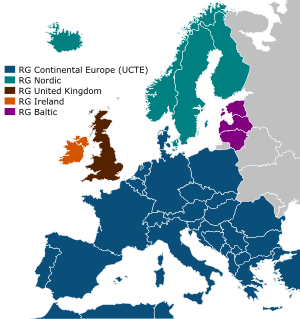
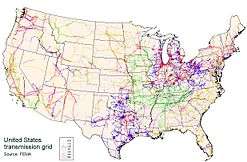
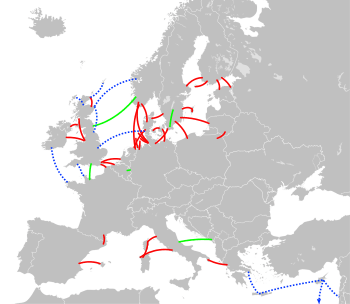
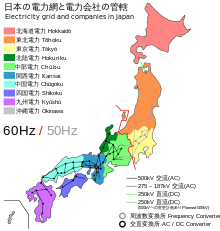
Voltage
Grids are designed to supply voltages at largely constant amplitudes. This has to be achieved with varying demand, variable reactive loads, and even nonlinear loads, with electricity provided by generators and distribution and transmission equipment that are not perfectly reliable.[16] Often grids use tap changers on transformers near to the consumers to adjust the voltage and keep it within specification.
Topologies
Transmission networks are complex with redundant pathways. For example, see the map of the United States' (right) high-voltage transmission network.
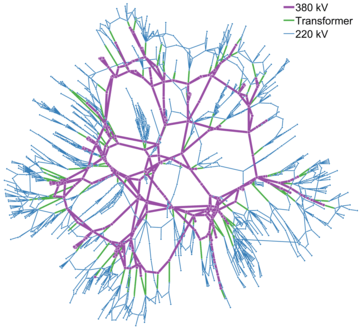
The structure, or "topology" of a grid can vary depending on the constraints of budget, requirements for system reliability, and the load and generation characteristics. The physical layout is often forced by what land is available and its geology. Distribution networks are divided into two types, radial or network.[18]
The simplest topology for a distribution or transmission grid is a radial structure. This is a tree shape where power from a large supply radiates out into progressively lower voltage lines until the destination homes and businesses are reached. However, single failures can take out entire branches of the tree.
Most transmission grids offer the reliability that more complex mesh networks provide. The expense of mesh topologies restrict their application to transmission and medium voltage distribution grids. Redundancy allows line failures to occur and power is simply rerouted while workmen repair the damaged and deactivated line.
Other topologies used are looped systems found in Europe and tied ring networks.
In cities and towns of North America, the grid tends to follow the classic radially fed design. A substation receives its power from the transmission network, the power is stepped down with a transformer and sent to a bus from which feeders fan out in all directions across the countryside. These feeders carry three-phase power, and tend to follow the major streets near the substation. As the distance from the substation grows, the fanout continues as smaller laterals spread out to cover areas missed by the feeders. This tree-like structure grows outward from the substation, but for reliability reasons, usually contains at least one unused backup connection to a nearby substation. This connection can be enabled in case of an emergency, so that a portion of a substation's service territory can be alternatively fed by another substation.
Synchronous grid
A synchronous grid or an "interconnection" is a group of distribution areas all operating with three phase alternating current (AC) frequencies synchronized (so that peaks occur at virtually the same time). This allows transmission of AC power throughout the area, connecting a large number of electricity generators and consumers and potentially enabling more efficient electricity markets and redundant generation.
A large failure in one part of the grid—unless quickly compensated for—can cause current to re-route itself to flow from the remaining generators to consumers over transmission lines of insufficient capacity, causing further failures. One downside to a widely connected grid is thus the possibility of cascading failure and widespread power outage. A central authority is usually designated to facilitate communication and develop protocols to maintain a stable grid. For example, the North American Electric Reliability Corporation gained binding powers in the United States in 2006, and has advisory powers in the applicable parts of Canada and Mexico. The U.S. government has also designated National Interest Electric Transmission Corridors, where it believes transmission bottlenecks have developed.
Some areas, for example rural communities in Alaska, do not operate on a large grid, relying instead on local diesel generators.[19]
Frequency
In a synchronous grid all the generators must run at the same frequency, and must stay very nearly in phase with each other and the grid. For rotating generators, a local governor regulates the driving torque, maintaining constant speed as loading changes. Droop speed control ensures that multiple parallel generators share load changes in proportion to their rating. Generation and consumption must be balanced across the entire grid, because energy is consumed as it is produced. Energy is stored in the immediate short term by the rotational kinetic energy of the generators.
Small deviations from the nominal system frequency are very important in regulating individual generators and assessing the equilibrium of the grid as a whole. When the grid is heavily loaded, the frequency slows, and governors adjust their generators so that more power is output (droop speed control). When the grid is lightly loaded the grid frequency runs above the nominal frequency, and this is taken as an indication by Automatic Generation Control systems across the network that generators should reduce their output.
In addition, there's often central control, which can change the parameters of the AGC systems over timescales of a minute or longer to further adjust the regional network flows and the operating frequency of the grid. For timekeeping purposes, the nominal frequency will be allowed to vary in the short term, but are adjusted to prevent line-operated clocks from gaining or losing significant time over the course of a whole 24 hour period.
An entire synchronous grid runs at the same frequency, neighbouring grids would not be synchronised even if they run at the same nominal frequency. High-voltage direct current lines or variable-frequency transformers can be used to connect two alternating current interconnection networks which are not synchronized with each other. This provides the benefit of interconnection without the need to synchronize an even wider area. For example, compare the wide area synchronous grid map of Europe with the map of HVDC lines.
Demand
The demand, or load on an electrical grid is the total electrical power being removed by the users of the grid.
Baseload is the minimum load on the grid over any given period, peak demand is the maximum load. Historically, baseload was commonly met by equipment that was cheap to run, that ran continuously for weeks or months at a time, but globally this is becoming less common. The peak demand requirements are sometimes produced by peaking plants that are generators optimised to come on-line quickly.
Production
The sum of the power outputs of generators on the grid is the production of the grid, typically measured in gigawatts (GW). The total energy produced is the integral of the power outputs, which is measured in gigawatt hours (GWh).
Transmission losses
It might be expected that demand and production might be equal, however, in practice power is lost in transmission lines and transformers in the transmission grid, so the demand plus the losses is equal to the production. Where power is being exported or imported to neighbouring grids that power is often considered as a demand or production respectively.
Capacity and firm capacity
The sum of the maximum power outputs (nameplate capacity) of the generators attached to an electrical grid might be considered to be the capacity of the grid.
However, in practice, they are never run flat out simultaneously. Typically, some generators are kept running at lower output powers (spinning reserve) to deal with failures as well as variation in demand. In addition generators can be off-line for maintenance or other reasons, such as availability of energy inputs (fuel, water, wind, sun etc.) or pollution constraints.
Firm capacity is the maximum power output on a grid that is immediately available over a given time period, and is a far more useful figure.
Grid code
Grid-connected equipment's behaviors are governed by a grid code which is a specification generally provided by the network operator. This ensures the grid stability and in particular specifies the correct behavior in off-nominal scenarios.
Interconnectors
Electric utilities between regions are many times interconnected for improved economy and reliability. Electrical interconnectors allow for economies of scale, allowing energy to be purchased from large, efficient sources. Utilities can draw power from generator reserves from a different region to ensure continuing, reliable power and diversify their loads. Interconnection also allows regions to have access to cheap bulk energy by receiving power from different sources. For example, one region may be producing cheap hydro power during high water seasons, but in low water seasons, another area may be producing cheaper power through wind, allowing both regions to access cheaper energy sources from one another during different times of the year. Neighboring utilities also help others to maintain the overall system frequency and also help manage tie transfers between utility regions.[10]
Electricity Interconnection Level (EIL) of a grid is the ratio of the total interconnector power to the grid divided by the installed production capacity of the grid. Within the EU, it has set a target of national grids reaching 10% by 2020, and 15% by 2030.[20]
Storage
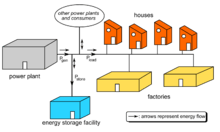
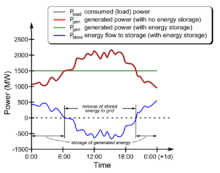
Grid energy storage (also called large-scale energy storage) is a collection of methods used to store electrical energy on a large scale within an electrical power grid. Electrical energy is stored during times when production (especially from intermittent power plants such as renewable electricity sources such as wind power, tidal power, solar power) exceeds consumption, and returned to the grid when production falls below consumption.
As of 2017, the largest form of grid energy storage is dammed hydroelectricity, with both conventional hydroelectric generation as well as pumped storage hydroelectricity. Alternatives include rail energy storage, where rail cars carrying large weights are moved up or down a section of inclined rail track, storing or releasing energy as a result; or disused oil-well potential energy storage, where weights are raised or lowered in a deep, decommissioned oil well.
Developments in battery storage have enabled commercially viable projects to store energy during peak production and release during peak demand.
Two alternatives to grid storage are the use of peaking power plants to fill in supply gaps and demand response to shift load to other times.
Failure
Brownout
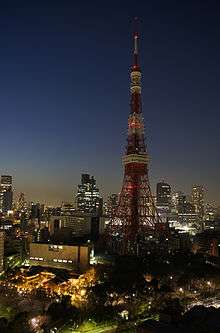
A brownout is an intentional or unintentional drop in voltage in an electrical power supply system. Intentional brownouts are used for load reduction in an emergency.[21] The reduction lasts for minutes or hours, as opposed to short-term voltage sag (or dip). The term brownout comes from the dimming experienced by incandescent lighting when the voltage sags. A voltage reduction may be an effect of disruption of an electrical grid, or may occasionally be imposed in an effort to reduce load and prevent a power outage, known as a blackout.[22]
Blackout
A power outage (also called a power cut, a power out, a power blackout, power failure or a blackout) is a loss of the electric power to a particular area.
Power failures can be caused by faults at power stations, damage to electric transmission lines, substations or other parts of the distribution system, a short circuit, cascading failure, fuse or circuit breaker operation, and human error.
Power failures are particularly critical at sites where the environment and public safety are at risk. Institutions such as hospitals, sewage treatment plants, mines, shelters and the like will usually have backup power sources such as standby generators, which will automatically start up when electrical power is lost. Other critical systems, such as telecommunication, are also required to have emergency power. The battery room of a telephone exchange usually has arrays of lead–acid batteries for backup and also a socket for connecting a generator during extended periods of outage.
Load shedding
Electrical generation and transmission systems may not always meet peak demand requirements— the greatest amount of electricity required by all utility customers within a given region. In these situations, overall demand must be lowered, either by turning off service to some devices or cutting back the supply voltage (brownouts), in order to prevent uncontrolled service disruptions such as power outages (widespread blackouts) or equipment damage. Utilities may impose load shedding on service areas via targeted blackouts, rolling blackouts or by agreements with specific high-use industrial consumers to turn off equipment at times of system-wide peak demand.
Black start

A black start is the process of restoring an electric power station or a part of an electric grid to operation without relying on the external electric power transmission network to recover from a total or partial shutdown.[23]
Normally, the electric power used within the plant is provided from the station's own generators. If all of the plant's main generators are shut down, station service power is provided by drawing power from the grid through the plant's transmission line. However, during a wide-area outage, off-site power from the grid is not available. In the absence of grid power, a so-called black start needs to be performed to bootstrap the power grid into operation.
To provide a black start, some power stations have small diesel generators, normally called the black start diesel generator (BSDG), which can be used to start larger generators (of several megawatts capacity), which in turn can be used to start the main power station generators. Generating plants using steam turbines require station service power of up to 10% of their capacity for boiler feedwater pumps, boiler forced-draft combustion air blowers, and for fuel preparation. It is uneconomical to provide such a large standby capacity at each station, so black-start power must be provided over designated tie lines from another station. Often hydroelectric power plants are designated as the black-start sources to restore network interconnections. A hydroelectric station needs very little initial power to start (just enough to open the intake gates and provide excitation current to the generator field coils), and can put a large block of power on line very quickly to allow start-up of fossil-fuel or nuclear stations. Certain types of combustion turbine can be configured for black start, providing another option in places without suitable hydroelectric plants.[24] In 2017 a utility in Southern California has successfully demonstrated the use of a battery energy storage system to provide a black start, firing up a combined cycle gas turbine from an idle state.[25]
Size
Wide area synchronous grid

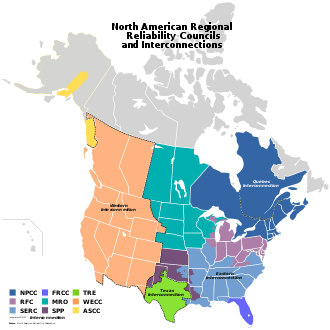
.png)
A wide area synchronous grid (also called an "interconnection" in North America) is an electrical grid at a regional scale or greater that operates at a synchronized frequency and is electrically tied together during normal system conditions. These are also known as synchronous zones, the largest of which is the synchronous grid of Continental Europe (ENTSO-E) with 667 gigawatts (GW) of generation, and the widest region served being that of the IPS/UPS system serving countries of the former Soviet Union. Synchronous grids with ample capacity facilitate electricity market trading across wide areas. In the ENTSO-E in 2008, over 350,000 megawatt hours were sold per day on the European Energy Exchange (EEX).[26]
Each of the interconnects in North America are run at a nominal 60 Hz, while those of Europe run at 50 Hz. Neighbouring interconnections with the same frequency and standards can be synchronized and directly connected to form a larger interconnection, or they may share power without synchronization via high-voltage direct current power transmission lines (DC ties), or with variable-frequency transformers (VFTs), which permit a controlled flow of energy while also functionally isolating the independent AC frequencies of each side.
The benefits of synchronous zones include pooling of generation, resulting in lower generation costs; pooling of load, resulting in significant equalizing effects; common provisioning of reserves, resulting in cheaper primary and secondary reserve power costs; opening of the market, resulting in possibility of long term contracts and short term power exchanges; and mutual assistance in the event of disturbances.[27]
One disadvantage of a wide-area synchronous grid is that problems in one part can have repercussions across the whole grid. For example, in 2018 Kosovo used more power than it generated due to a row with Serbia, leading to the phase across the whole synchronous grid of Continental Europe lagging behind what it should have been. The frequency dropped to 49.996 Hz. This caused certain kinds of clocks to become six minutes slow.[28]
Microgrid
A microgrid is a localized group of electricity sources and loads that normally operates connected to and synchronous with the traditional wide area synchronous grid (macrogrid), but can also disconnect to "island mode" – and function autonomously as physical and/or economic conditions dictate.[29]
In this way, a microgrid can effectively integrate various sources of distributed generation, especially renewable energy sources, and can supply emergency power, changing between island and connected modes.
Control and protection are challenges to microgrids.[30][31][32]
Super grids
Various planned and proposed systems to dramatically increase transmission capacity are known as super, or mega grids. The promised benefits include enabling the renewable energy industry to sell electricity to distant markets, the ability to increase usage of intermittent energy sources by balancing them across vast geographical regions, and the removal of congestion that prevents electricity markets from flourishing. Local opposition to siting new lines and the significant cost of these projects are major obstacles to super grids. One study for a European super grid estimates that as much as 750 GW of extra transmission capacity would be required- capacity that would be accommodated in increments of 5 GW HVDC lines. A recent proposal by Transcanada priced a 1,600-km, 3-GW HVDC line at US$3 billion and would require a wide corridor. In India, a recent 6 GW, 1,850-km proposal was priced at $790 million and would require a wide right of way. With 750 GW of new HVDC transmission capacity required for a European super grid, the land and money needed for new transmission lines would be considerable.
Trends
Increasing electrification
The number of people with access to grid electricity is growing. About 840 million people (mostly in Africa) had no access to grid electricity in 2017, down from 1.2 billion in 2010.[33]
Demand response
Demand response is a grid management technique where retail or wholesale customers are requested either electronically or manually to reduce their load. Currently, transmission grid operators use demand response to request load reduction from major energy users such as industrial plants.[34]
Aging infrastructure
Despite the novel institutional arrangements and network designs of the electrical grid, its power delivery infrastructures suffer aging across the developed world. Contributing factors to the current state of the electric grid and its consequences include:
- Aging equipment – older equipment has higher failure rates, leading to customer interruption rates affecting the economy and society; also, older assets and facilities lead to higher inspection maintenance costs and further repair and restoration costs.
- Obsolete system layout – older areas require serious additional substation sites and rights-of-way that cannot be obtained in the current area and are forced to use existing, insufficient facilities.
- Outdated engineering – traditional tools for power delivery planning and engineering are ineffective in addressing current problems of aged equipment, obsolete system layouts, and modern deregulated loading levels.
- Old cultural value – planning, engineering, operating of system using concepts and procedures that worked in vertically integrated industry exacerbate the problem under a deregulated industry.[35]
- One countermeasure against cascading failures from exploding high-voltage transformers is high-voltage transformer fire barriers.
Modernization
Thirty-seven states plus the District of Columbia took some action to modernize electric grids in the first quarter of 2017, according to the North Carolina Clean Energy Technology Center. The states did so to make electricity systems "more resilient and interactive". The most common actions that states took were "advanced metering infrastructure deployment" (19 states did this), smart grid deployment and "time-varying rates for residential customers".[36]
Legislatively, in the first quarter of the year 82 relevant bills were introduced in different parts of the United States. At the close of the quarter, most of the bills remained pending. For example, legislators in Hawaii introduced a bill that would create an energy storage tax credit. In California, the state Senate had a bill that would "create a new energy storage rebate program".[36]
In August 2018, Advanced Energy Economy (AEE) and Citizens for Responsible Energy Solutions Forum (CRES Forum) published a policy paper that gave five recommendations on ways to modernize the U.S. electric power grid. These recommendations are to streamline the federal permit process for advanced energy projects; encourage grid planners to consider alternatives to investment in transmission; allow energy storage and energy efficiency to compete with additional energy generation; allow large customers to choose their own sources of electricity; and allow utilities and consumers to benefit from cloud computing software.[37]
Distributed generation
With everything interconnected, and open competition occurring in a free market economy, it starts to make sense to allow and even encourage distributed generation (DG). Smaller generators, usually not owned by the utility, can be brought on-line to help supply the need for power. The smaller generation facility might be a home-owner with excess power from their solar panel or wind turbine. It might be a small office with a diesel generator. These resources can be brought on-line either at the utility's behest, or by owner of the generation in an effort to sell electricity. Many small generators are allowed to sell electricity back to the grid for the same price they would pay to buy it.
As the 21st century progresses, the electric utility industry seeks to take advantage of novel approaches to meet growing energy demand. Utilities are under pressure to evolve their classic topologies to accommodate distributed generation. As generation becomes more common from rooftop solar and wind generators, the differences between distribution and transmission grids will continue to blur. In July 2017 the CEO of Mercedes-Benz said that the energy industry needs to work better with companies from other industries to form a "total ecosystem", to integrate central and distributed energy resources (DER) to give customers what they want. The electrical grid was originally constructed so that electricity would flow from power providers to consumers. However, with the introduction of DER, power needs to flow both ways on the electric grid, because customers may have power sources such as solar panels.[38]
Smart grid
The smart grid would be an enhancement of the 20th century electrical grid, using two-way communications and distributed so-called intelligent devices. Two-way flows of electricity and information could improve the delivery network. Research is mainly focused on three systems of a smart grid – the infrastructure system, the management system, and the protection system.[39]
The infrastructure system is the energy, information, and communication infrastructure underlying of the smart grid that supports:
- Advanced electricity generation, delivery, and consumption
- Advanced information metering, monitoring, and management
- Advanced communication technologies
A smart grid would allow the power industry to observe and control parts of the system at higher resolution in time and space.[40] One of the purposes of the smart grid is real time information exchange to make operation as efficient as possible. It would allow management of the grid on all time scales from high-frequency switching devices on a microsecond scale, to wind and solar output variations on a minute scale, to the future effects of the carbon emissions generated by power production on a decade scale.
The management system is the subsystem in smart grid that provides advanced management and control services. Most of the existing works aim to improve energy efficiency, demand profile, utility, cost, and emission, based on the infrastructure by using optimization, machine learning, and game theory. Within the advanced infrastructure framework of smart grid, more and more new management services and applications are expected to emerge and eventually revolutionize consumers' daily lives.
The protection system of a smart grid provides grid reliability analysis, failure protection, and security and privacy protection services. While the additional communication infrastructure of a smart grid provides additional protective and security mechanisms, it also presents a risk of external attack and internal failures. In a report on cyber security of smart grid technology first produced in 2010, and later updated in 2014, the US National Institute of Standards and Technology pointed out that the ability to collect more data about energy use from customer smart meters also raises major privacy concerns, since the information stored at the meter, which is potentially vulnerable to data breaches, can be mined for personal details about customers.[41]
In the U.S., the Energy Policy Act of 2005 and Title XIII of the Energy Independence and Security Act of 2007 are providing funding to encourage smart grid development. The objective is to enable utilities to better predict their needs, and in some cases involve consumers in a time-of-use tariff. Funds have also been allocated to develop more robust energy control technologies.[42][43]
Grid defection
As there is some resistance in the electric utility sector to the concepts of distributed generation with various renewable energy sources and microscale cogen units, several authors have warned that mass-scale grid defection is possible because consumers can produce electricity using off grid systems primarily made up of solar photovoltaic technology.[44][45][46]
The Rocky Mountain Institute has proposed that there may be widescale grid defection.[47] This is backed up by studies in the Midwest.[48] However, the paper points out that grid defection may be less likely in countries like Germany which have greater power demands in winter.[49]
Utilities and oligopoly
Due to the enormous capital outlays, utilities were a vertically integrated business throughout the 20th century owning the power generation, the (transmission) lines while also managing the bills (commercialization). Presently, technological progress has enabled individuals and groups to take on the functions that used to be the sole domain of the utility. Adding to the shift is the impact of aging infrastructure on reliability, security and performance factors.[50]
See also
References
| Wikimedia Commons has media related to Power grids. |
- Kaplan, S. M. (2009). Smart Grid. Electrical Power Transmission: Background and Policy Issues. The Capital.Net, Government Series. Pp. 1-42.
- Overland, Indra (2016-04-01). "Energy: The missing link in globalization". Energy Research & Social Science. 14: 122–130. doi:10.1016/j.erss.2016.01.009. Archived from the original on 2018-02-05.
[...] if all countries in the world were to make do with their own resources, there would be even more energy poverty in the world than there is now. Currently, 1.4 billion people are not connected to an electricity grid [...]
- Douris, Constance. "As Cyber Threats To The Electric Grid Rise, Utilities And Regulators Seek Solutions". Forbes. Retrieved 2018-09-27.
- Overland, Indra (2019-03-01). "The geopolitics of renewable energy: Debunking four emerging myths". Energy Research & Social Science. 49: 36–40. doi:10.1016/j.erss.2018.10.018. ISSN 2214-6296.
- Borberly, A. and Kreider, J. F. (2001). Distributed Generation: The Power Paradigm for the New Millennium. CRC Press, Boca Raton, FL. 400 pgs.
- Mr Alan Shaw (29 September 2005). "Kelvin to Weir, and on to GB SYS 2005" (PDF). Royal Society of Edinburgh. Archived (PDF) from the original on 4 March 2009.
- "Survey of Belford 1995". North Northumberland Online.
- "Lighting by electricity". The National Trust. Archived from the original on 2011-06-29.
- Mazer, A. (2007). Electric Power Planning for Regulated and Deregulated Markets. John, Wiley, and Sons, Inc., Hoboken, NJ. 313pgs.
- . (2001). Glover J. D., Sarma M. S., Overbye T. J. (2010) Power System and Analysis 5th Edition. Cengage Learning. Pg 10.
- People's Republic of China Year Book. Xinhua Publishing House. 1989. p. 190.
- China Report: Economic affairs. Foreign Broadcast Information Service, Joint Publications Research Service. 1984. p. 54.
- "Hong Kong Express Rail Link officially openes". Xinhuanet.com. 2018-10-03.
- Avishek G Dastidar (September 13, 2018). "After initial questions, government clears 100% Railways electrification". The Indian Express.
- "Beijing–Zhangjiakou intercity railway openes". National Development and Reform Commission. Jan 6, 2020.
- "Archived copy" (PDF). Archived (PDF) from the original on 2018-05-08. Retrieved 2017-08-28.CS1 maint: archived copy as title (link)
- Cuffe, Paul; Keane, Andrew (2017). "Visualizing the Electrical Structure of Power Systems". IEEE Systems Journal. 11 (3): 1810–1821. Bibcode:2017ISysJ..11.1810C. doi:10.1109/JSYST.2015.2427994. hdl:10197/7108. ISSN 1932-8184.
- Abdelhay A. Sallam & Om P. Malik (May 2011). Electric Distribution Systems. IEEE Computer Society Press. p. 21. ISBN 9780470276822.
- Energy profile of Alaska, United States Archived 2009-07-27 at the Wayback Machine, Editor: Cutler J. Cleveland, Last Updated: July 30, 2008 - Encyclopedia of Earth
- Mezősi, András; Pató, Zsuzsanna; Szabó, László (2016). "Assessment of the EU 10% interconnection target in the context of CO2 mitigation†". Climate Policy. 16 (5): 658–672. doi:10.1080/14693062.2016.1160864.
- Steven Warren Blume Electric power system basics: for the nonelectrical professional. John Wiley & Sons, 2007 ISBN 0470129875 p. 199
- Alan Wyatt, Electric Power Challenges and Choices, The Book Press Limited, Toronto, 1986 ISBN 0-920650-00-7 page 63
- Knight, U.G. Power Systems in Emergencies - From Contingency Planning to Crisis Management John Wiley & Sons 2001 ISBN 978-0-471-49016-6 section 7.5 The 'Black Start' Situation
- Philip P. Walsh, Paul Fletcher Gas turbine performance, John Wiley and Sons, 2004 ISBN 0-632-06434-X, page 486
- "California battery's black start capability hailed as 'major accomplishment in the energy industry'".
- "EEX Market Monitor Q3/2008" (PDF). Leipzig: Market Surveillance (HÜSt) group of the European Energy Exchange. 2008-10-30: 4. Retrieved 2008-12-06. Cite journal requires
|journal=(help) - Haubrich, Hans-Jürgen; Dieter Denzel (2008-10-23). "Characteristics of interconnected operation" (PDF). Operation of Interconnected Power Systems (PDF). Aachen: Institute for Electrical Equipment and Power Plants (IAEW) at RWTH Aachen University. p. 3. Archived from the original (PDF) on 2011-07-19. Retrieved 2008-12-06. (See "Operation of Power Systems" link for title page and table of contents.)
- "Serbia, Kosovo power grid row delays European clocks". Reuters. Mar 7, 2018.
- "About Microgrids".
- Saleh, Mahmoud; Esa, Yusef; Mhandi, Yassine; Brandauer, Werner; Mohamed, Ahmed (2016). "Design and implementation of CCNY DC microgrid testbed". Design and implementation of CCNY DC microgrid testbed - IEEE Conference Publication. pp. 1–7. doi:10.1109/IAS.2016.7731870. ISBN 978-1-4799-8397-1.
- Saleh, Mahmoud; Esa, Yusef; Mohamed, Ahmed (2018). "Communication Based Control for DC Microgrids - IEEE Journals & Magazine". IEEE Transactions on Smart Grid. 10: 1. doi:10.1109/TSG.2018.2791361.
- "A Survey of Techniques for Designing and Managing Microgrids", IEEE PES GM 2015
- Closing Sub-Saharan Africa’s Electricity Access Gap: Why Cities Must Be Part of the Solution
- "Industry Cross-Section Develops Action Plans at PJM Demand Response Symposium". Reuters. 2008-08-13. Archived from the original on 2009-02-19. Retrieved 2008-11-22.
Demand response can be achieved at the wholesale level with major energy users such as industrial plants curtailing power use and receiving payment for participating.
- Willis, H. L., Welch, G. V., and Schrieber, R. R. (2001). Aging Power Delivery Infrastructures. Marcel Dekker, Inc. : New York. 551 pgs.
- "Nearly three quarters of US took steps toward grid modernization in first quarter, study finds". Daily Energy Insider. 2017-05-25. Archived from the original on 2018-05-08. Retrieved 2017-06-05.
- "Five ways to modernize the U.S. electric power grid via Advanced Energy Economy | Solar Builder". Solar Builder Magazine. 2018-08-06. Retrieved 2018-08-30.
- Randolph, Kevin (2017-07-21). "In order to integrate the grid, disparate industries need to work together". Daily Energy Insider. Retrieved 2017-08-03.
- Smart Grid - The New and Improved Power Grid: A Survey; IEEE Communications Surveys and Tutorials 2011; X. Fang, S. Misra, G. Xue, and D. Yang; doi:10.1109/SURV.2011.101911.00087.
- Alexandra Von Meier (2013). Electrical Engineer 137A: Electric Power Systems. Lecture 2:Introduction to Electric Power Systems, Slide 33.
- Nunez, Christina (December 14, 2012). "Who’s Watching? Privacy Concerns Persist as Smart Meters Roll Out Archived 2018-03-16 at the Wayback Machine". National Geographic. nationalgeographic.com. Retrieved 2018-03-16.
- "U.S. Energy Independence and Security Act of 2007". Archived from the original on 2015-12-19. Retrieved 2007-12-23.
- DOE Provides up to $51.8 Million to Modernize the U.S. Electric Grid System Archived 2008-09-20 at the Wayback Machine, June 27, 2007, U.S. Department of Energy (DOE)
- Kantamneni, Abhilash; Winkler, Richelle; Gauchia, Lucia; Pearce, Joshua M. (2016). "free open access Emerging economic viability of grid defection in a northern climate using solar hybrid systems". Energy Policy. 95: 378–389. doi:10.1016/j.enpol.2016.05.013.
- Khalilpour, R.; Vassallo, A. (2015). "Leaving the grid: An ambition or a real choice?". Energy Policy. 82: 207–221. doi:10.1016/j.enpol.2015.03.005.
- Kumagai, J (2014). "The rise of the personal power plant". IEEE Spectrum. 51 (6): 54–59. doi:10.1109/mspec.2014.6821622.
- The Economics of Grid Defection - Rocky Mountain Institute "The Economics of Grid Defection". Archived from the original on 2016-08-12. Retrieved 2016-08-13.
- Andy Balaskovitz Net metering changes could drive people off grid, Michigan researchers say Archived 2016-06-15 at the Wayback Machine - MidWest Energy News
- "Grid defection and why we don't want it". 2015-06-16.
- Aging And Unstable, The Nation's Electrical Grid Is 'The Weakest Link'.
External links
- Map of U.S. generation and transmission
- U.S. electric system is made up of interconnections and balancing authorities, U.S. Energy Information Administration (EIA).